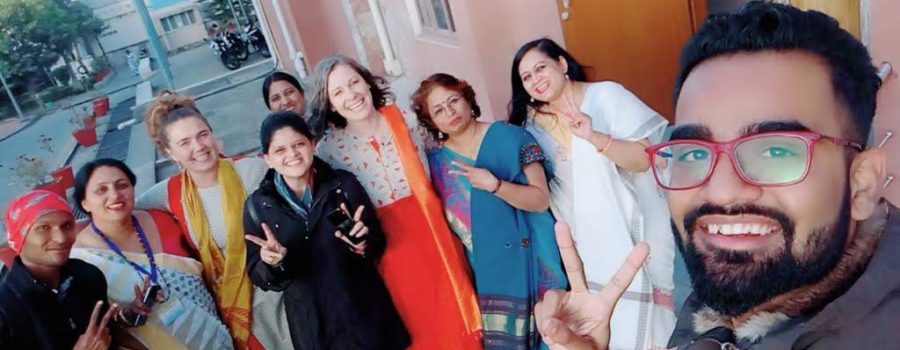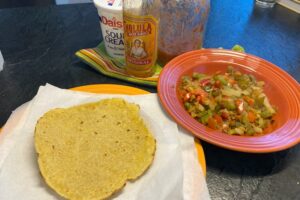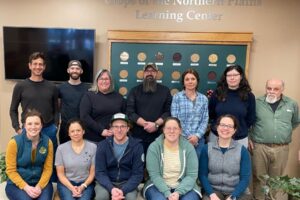Finally, we landed in India through Delhi’s Indira Gandhi International Airport – one of the busiest airports in the world. The place was buzzing with travelers from nearly every continent intersecting at this singular Old Spice Road crossing. There was a lot of security (what appeared to be peacekeepers with assault rifles), more than what we were used to seeing; however, we moved swiftly enough through customs and were well on our way to finding our connection to Bhopal (the state capital of Madhya Predesh) via AirIndia.
Everything seemed easier knowing that we had friends meeting us on the other side of our next arrival gate. Most of our friends we had never met (in person), though we had been connecting over email the last several weeks in prep for the Regional Institute of Education (RIE) Bhopal’s first ever International Conference on Emerging Trends and Innovations in School Sciences. We weren’t sure who was picking us up or where we were going exactly, but we were happy to get there and embrace all that this adventure would bring.
Bhopal’s Devastating Past
Many people across the world know Bhopal as the site of the World’s Worst Industrial Disaster that happened nearly 35 years ago in December of 1984. An horrific accident at the Union Carbide Corporation (UCC) Pesticide Plant (an American-owned and operated company) released at least 30 tons of a highly toxic gas called methyl isocynate (used to produce the pesticide Sevin). It is estimated by government officials that at least 16,000 people died and nearly 600,000 people were injured by the accident, especially some of the most vulnerable residents living in shanty towns near the plant. Yet, despite such a tragedy, the people of Bhopal have not let the sorrow and grief of this awful event DEFINE the place they call home. As ripples of this great disaster begin to soften and grow more distant from this beautiful place they call the ‘City of Lakes,’ the people of Bhopal have started to change the narrative.
A ‘City Of Lakes’ Sparkles
The people of Bhopal emulate a feeling of goodness and trust in things, and the idea that there is always growing and learning to be done. And, that everyone plays a role in that growing and learning best done when done together. It only made sense that from this incredible place of resiliency and optimism that the local community would bring forth the FIRST International Conference on School Sciences. We were so honored and humbled to be part of the event. We met students, teachers, scientists, and professors from all over India as well as other nations who came together to share ideas and practices to build scientific community and literacy.

Virginia with Dr. Mostafa from Bangladesh at the conference 
Dr. Piyush Swami delivers keynote address 
Virginia doing her thing 
Getting a selfie in with new friends
During our visit, we were moved to tears more than once by the overwhelming challenges for children and families to gain access to basic essentials – clean water and free education, as well as the AMAZING passion and innovations of community-minded people (and youth) developing solutions to overcome these challenges and barriers. We were honored to meet so many incredible people, including Pallabi Mahapatro. Pallabi is the mentor and teacher of a 13 year old, rural Indian girl – Lalita Prasida, who’s corn-cob water purifier invention has brought back clean water from wastewater to poor villages across India and elsewhere. The Google Science Fair award winner’s low-cost water filtration system cleans wastewater by flowing it through different layers of corn cobs: long pieces, small pieces, powdered corn cobs, activated charcoal made from corn cobs, and fine sand. Watch Lalita’s Ted Talk here as she describes how her project uses one agricultural waste to counter another agricultural waste. SO AWESOME. So Inspiring.
Yet, ‘INSPIRED’ hardly describes all that we felt and what was moved into us from the people we met and the stories and ideas shared; it was more of an ‘ON FIRE!’ – to do all that we can do and be all that we can be with all the amazing resources and opportunities we’ve been offered.


ASIDE from the work meetings, our generous hosts made sure we had some time to experience the vast richness of the local culture through Bhopal’s cuisine, textiles, and cultural exhibits. Just when we thought the trip couldn’t get any better…
Starting With the Food
The chow was EXCEPTIONAL, and totally lived up to the hype! Our hosts fed our band of internationals delicious home-cooked, family style meals at nearly every sitting – it was like eating out a different Indian grandmother’s kitchen for EVERY meal! I once read that India’s cuisine is a combination of subtle tastes where flavors are as varied as India’s climate and as exotic as India’s people. Colorful, zesty, rich, and warm plates with a delicate flare of elegance and deep respect for social graces greeted us at nearly every meal and tea.

The different spices and aromas found mixed with a variety of vegetables, pulses (beans, peas, lentils, nuts), and grains (rice or bread) were delightful, accompanied with chutneys, salads, and raitas that provided some tangy taste. Each meal was followed with a sweet treat ‘to aide in digestion’ our hosts would say. I say ‘YES PLEASE!’ The sweets were sometimes fresh fruit accompanied with some other creative flavors paired with Greek yogurt with essence of rose water and a little cardamom, or sometimes the deserts were cooked and cake-like and drizzled in a sugary syrup. We always walked away from the dining table overly content with our bellies feeling quite satisfied and loaded!
Sarees, Silks, and Textiles – OH MY!
We made our way out to the local shops and markets and continued to make brilliant discoveries. Our hosts took us to a local tailor shop in Bhopal called Malvika – a house of traditional Sarees, Salwar-suits, and fabrics to be fitted for authentic Indian dress. We were enamored and overwhelmed by the incredible mountains of perfectly organized, ethnic fabrics – Tussar, Chanderi, Maheshwari, Crepe, Chiffon, Cotton, and more… At official events such as the conference, the Indian women’s dress is of pure elegance and brilliance with fascinating and majestic colors woven into a beautiful, FIVE to NINE meter Saree (that’s basically 15 to 27 FEET of FABRIC wrapped to perfection). Given our time constraints and functionality (let’s face it – we weren’t sure we were capable of wrapping the Saree and then our ability to haul it around while traveling – was also in question!), we opted for the business casual look and found something we could wear as we trekked across India. Needless-to-say, we were thrilled with our dress!
Chowk Bazaar’s Street Food
Eventually, we made it to the local Chowk Bazaar at the center of the city that was SOOO MUCH more laid-back than any of the Souks in Dubai. Here you could find ANYTHING, and not feel the constant push to haggle (as we experienced in Dubai). Clothes, electronics, jewels, spices, fabrics, home decor, temples of worship, a fun crowd to watch, and more. You could easily get lost spending a day here and easily find the BEST prices on goods in India here. BUT, our purpose was one-dimensional, and that purpose was Bhopal STREET FOOD! One of the esteemed guests and keynote speaker of the conference Dr.Piyush Swami, took it upon himself to show us how to do the local cuisine. We tried Pani Puri (something hard to find in the US), Chile Paneer (Ben’s new favorite Indian Fusion Dish), and Aloo Tikka (Virginia’s new favorite Indian Dish). We were told ‘the key is to eat just a little, and make sure it’s hot’ – admittedly, it was truly hard not to over-indulge on all the deliciousness! NO, ‘Delhi Belly’ here – we did just fine tasting the street food and we encourage you to do the same – all in moderation, right?! 🙂

A Rich Cultural Heritage
Our dear friends from RIE, organized a trip for us to visit the ancient Buddhist complex of Sanchi located about 30 miles north east of Bhopal. The drive out to visit the World Heritage Site across the countryside was awesome in and of itself. We saw many small lentil and wheat farms, as well as the Betwa River that provides irrigation to many hundreds of thousands of acres of farmland. Our travel wagon drove up a winding hilltop that delivered us to the Great Stupa (a mound-like structure containing relics – often used as a place of meditation) at Sanchi that is one of the oldest stone structures in India. Again, we found ourselves mystified and in awe to be in the presence of the stone remains from 2nd Century BCE – which just made us want to learn more!

Ben & Virginia explore Sanchi 
Buddhist shrine near the entrance of the Great Stupa 
Fantastic tour guide showing us the Great Stupa on the 200 Rupee note 
The Great Stupa of Sanchi
With one evening left in Bhopal, it was easily decided that we’d spend it at the Tribal Museum – ‘An ode to tribal art and culture’ nestled in the Shymala Hills. We’ve been to many museums and galleries across the world, and Bhopal’s Tribal Museum’s beautifully planned galleries, lighting, and layout rival any museum in its artistic ability to connect the visitor to tribal lifestyle through motifs, artifacts, and dramatic lighting. It’s simply phenomenal. It is a true celebration of life and an enthusiastic nod to the way tribal life is lived across the seven major tribes in the state of Madhya Predesh – the Gond, Bhil, Korku, Baiga, Sahariya, Kol, and Bhariya – through their handicrafts, colorful aesthetics, and spiritual beliefs. It is a must see!
So Hard to Say Goodbye
Looking back upon our last hours in Bhopal, we reflect and give thanks to this wondrous place that gave us so many reasons to celebrate and be hopeful for the beauty, strife, love, grief, resilience, color, tenacity, and optimism that is all part of life and found in this one sacred place. As we woke up early the morning of our departure surrounded by new friends sending us off, we were already longing for our return to this incredible place and our lovely new friends…

Stay tuned for Part III of our journey where we visit Delhi, the Taj Mahal, and travel north to the Himalayas and the ‘birthplace of yoga!’


















Leave a Reply
Your email is safe with us.